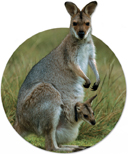
FIGURE 28–24 Marsupials Marsupial young, such as this wallaby peeking out of its mother's pouch, are born at a very early stage of development. They complete their development nursing in their mother's pouch.
▸ Marsupials Marsupials, such as the wallabies in Figure 28–24, bear live young that usually complete their development in an external pouch. Marsupial young are born at a very early stage of development. Little more than embryos, they crawl across their mother's fur and attach to a nipple in her pouch, or marsupium (mar SOO pee um). Inside the marsupium, the young spend months attached to a nipple. They continue drinking milk and growing inside the marsupium until they can survive independently.
▸ Placentals Placental mammals, such as the harp seals shown in Figure 28–25, are named for the placenta, which allows nutrients, oxygen, carbon dioxide, and other wastes to be exchanged between the embryo and the mother. The placenta allows the embryo to develop for a long time inside the mother and allows it to be born at a fairly advanced stage of development.

FIGURE 28–25 Placental Mammals Placental mammals, such as harp seals, are nourished through a placenta before they are born and by their mother's milk after they are born.
28.3 Assessment

-
Review Compare asexual reproduction and sexual reproduction in terms of the genetic diversity resulting from each.
Infer Why might sexual reproduction, as opposed to asexual reproduction, produce a population better able to survive disease or environmental changes?
-
Review Define the two types of fertilization.
Predict Why would you expect species that employ external fertilization to reproduce in the water?
-
Review Define the three ways in which embryos develop.
Compare and Contrast What is the difference between a nymph and a pupa?
-
Review What structure enables reptiles and birds to reproduce outside of water?
Interpret Visuals In your own words, describe the functions of two of the membranes shown in Figure 28–22.
WRITE ABOUT SCIENCE
Write an advertisement for an amniotic egg. Draw and label the parts of the egg, including each of the membranes and the shell. Describe the purpose of each structure and how it's ideally suited for its function.

Table of Contents
- Formulas and Equations
- Applying Formulas and Equations
- Mean, Median, and Mode
- Estimation
- Using Measurements in Calculations
- Effects of Measurement Errors
- Accuracy
- Precision
- Comparing Accuracy and Precision
- Significant Figures
- Calculating With Significant Figures
- Scientific Notation
- Calculating With Scientific Notation
- Dimensional Analysis
- Applying Dimensional Analysis




